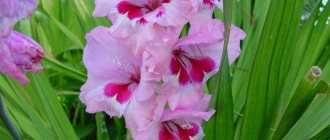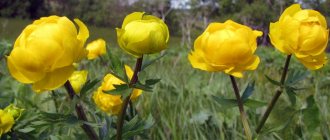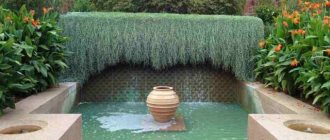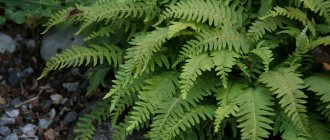Author: Elena N. https://floristics.info/ru/index.php?option=com_contact&view=contact&id=19 Category: Garden plants Published: February 25, 2019Last edits: January 13, 2021
- When to plant
- Growing conditions
Dichondra (lat. Dichondra) is a genus of herbaceous evergreen perennials of the Convolvulaceae family, whose representatives are relatives of plants such as morning glory, calistegia and bindweed. The name “dichondra” consists of two Greek words, which translated mean “two grains” - this is due to the fact that the fruits of the plant look like a two-chambered capsule. There are 10 species in the genus, which naturally grow in humid places in the tropics and subtropics of Australia, New Zealand, East Asia and America. The dichondra plant has been used in floriculture not so long ago, but with its help, designers have learned to create magnificent compositions, so it is not surprising that in 2004, at an exhibition in Moscow, the plant received a silver medal.
Planting and caring for dichondra
- Flowering: grown as an ornamental foliage plant.
- Planting: sowing seeds for seedlings - in January-February, planting seedlings in open ground - from late May to mid-June.
- Lighting: bright sunlight, diffused light, partial shade and even shade. Plants with silver leaves are more light-loving.
- Soil: well-drained loams with a pH of 6.6-8.0.
- Watering: regular, but moderate, in the evenings, so that there are no burns on the leaves.
- Air humidity: in hot weather and drought, evening spraying of leaves is recommended.
- Feeding: 2 times a month during the growing season with complex mineral fertilizer with a predominance of nitrogen and potassium.
- Pinching and pruning: at the stage of development of 4 pairs of leaves, shoots are pinched for better tillering. As the shoots grow, they are pruned once every two weeks.
- Reproduction: seed and vegetative - cuttings and layering.
- Pests: nematodes, whiteflies, aphids and flea beetles.
- Diseases: practically not affected.
Read more about growing dichondra below.
Possible diseases and pests
Aphids, whiteflies and garden flea beetles are the most common pests that plague the Dichondra plant; they can be easily neutralized through the use of mild insecticides, which is important for preserving the green cover.
It is recommended to remove weeds manually, avoiding damage to shoots and leaves during flowering; to improve growth, fertilize with weak nitrogen solutions; in case of strong growth, it is enough to reduce the frequency of watering.
Botanical description
The dichondra flower is an evergreen creeping plant that forms a dense carpet on the soil surface. The root system of dichondra is superficial. The height of the shoots is only 15 cm, but their length can reach from 1 to 1.5 m. The stems of the plant are creeping, branched, quickly rooting with the help of superficial roots formed in the internodes. Inconspicuous greenish, purple or yellowish flowers with a diameter of 2-3 mm bloom from May to August. Dichondra is pollinated by small insects. Its round leaves, like coins with a diameter of 0.5 to 2.5 cm, cover the stems very densely.
Ampelous dichondra is popular in culture: in areas with cold winters it is grown as an annual plant, and in areas with warm and mild winters – as a perennial. The domestic dichondra spends the winter indoors and the summer on the balcony or terrace. Growing dichondra is an easy and enjoyable activity, and we will tell you how to grow dichondra from seeds, how to plant and care for dichondra at home and in the garden.
Cultivation and application in design
Looking at the photo of Dichondra, you can choose the best type of flower, suitable for decorating a summer cottage or lawn, for use in landscape design and as an original decoration for a gazebo, terrace or veranda.
Growing the plant is not difficult even for novice gardeners; it grows on different soils, but on fertile soil with good and frequent watering, the flower develops larger leaves and intensive growth is observed.
Growing dichondra from seeds
How to sow seeds
To grow dichondra in an annual culture, both generative and vegetative propagation are used - rooting of layering and summer cuttings, and for primary cultivation, the seed method, seedlings and non-seedlings, is used. Dichondra is sown for seedlings in the middle of winter, in January-February. Before sowing, dichondra seeds are soaked overnight in water with a growth stimulant. Sowing of dichondra is carried out in a sterile peat soil substrate for seedlings, watered with sodium humate. The embedment depth is no more than 8 mm. As a container, it is better to use pots in which 2-3 seeds are placed. The crops are covered with film or glass, leaving a small hole for ventilation, and kept under diffused light at a temperature of 22-24 ºC.
- Video of preparing Brugmansia for wintering in an apartment
Seedling care
Under favorable conditions, the first shoots may appear within a week. The seedlings grow very slowly, but when they get stronger, the covering can be removed. Caring for seedlings involves regular watering and careful loosening of the substrate. Make sure that dichondra seedlings receive enough light, otherwise the seedlings may painfully stretch out.
From time to time, you can add a little growth stimulant to the water for watering the seedlings. At the stage of formation of 3-4 leaves of dichondra, seedlings are picked: if you are going to grow the plant as an ampel, in a flowerpot or basket, then transplant it immediately to a permanent place, and if you expect to plant it in the garden, then pick the seedlings into larger containers. Before planting in open ground, dichondra from seeds must undergo hardening procedures.
Sowing seeds
When growing from seeds, you should scatter or sow at the rate of 450 grams per 46–92 square meters. meters. A higher concentration will give the rack density.
Rake the seeds to lightly cover them. A very shallow covering of peat moss or similar organic matter will help retain moisture until your seeds germinate.
Planting dichondra in the garden
When to plant
In warm areas, dichondra is often used to form an alternative lawn due to its cold resistance and resistance to trampling. Planting the ampelous dichondra in open ground is done one and a half to two months after the emergence of seedlings. The approximate dates for planting seedlings for the southern regions are May, and for the northern regions - early or mid-June.
Dichondra grows well both in the sun and in the shade, but the variety with silver leaves is more light-loving. The plant is undemanding in terms of soil composition, but prefers loamy, well-drained soils with a pH of 6.6-8.
How to plant
If you want to use dichondra as a ground cover plant, keep in mind that it grows very slowly, so the seedlings need to be planted close to each other - at a distance of 10-15 cm. Make holes of such depth that the seedlings can fit in them along with a ball of earth, transfer the seedlings, fill the holes with soil, compact the surface and water.
Caring for dichondra in the garden
Garden dichondra, subject to simple care rules, can remain decorative for 5 to 7 years. Despite the fact that the plant is drought-resistant, try to water it regularly, but waterlogging the soil is not recommended. To avoid leaf burn, try to water the ground cover dichondra in the evenings. And do not forget about spraying the plant in the hot season - dichondra grows well in high air humidity.
- Elecampane: properties and contraindications, planting and care
To achieve a high level of decorativeness of dichondra, it is necessary to apply complex mineral fertilizer with a predominance of potassium and nitrogen to the soil twice a month during the growing season.
After the appearance of eight leaves, it is advisable to pinch the stems of the dichondra, and then, as the plant grows and branches, the plant should be pruned - usually one pruning every two weeks is sufficient during the summer.
Weed control requires caution, since it is very easy to damage the roots of dichondra, located at a shallow depth.
Landing conditions
Dichondra seeds need warm soil temperatures to germinate. It should be planted when the temperature is above 20 degrees.
Typically in most regions this is late spring or early summer. When soil temperatures are too cold, seed germination and lawn establishment are much slower and more maintenance is required.
Dichondra care at home
Growing conditions
Caring for dichondra at home is simple, as is caring for other decorative foliage ampels - chlorophytum, creeping ficus, rooting ficus, asparagus, saxifrage or zebrina, but before you grow dichondra at home, you need to study its botanical characteristics and preferences . The level of illumination for a dichondra is determined by the color of its leaves: for plants with a green color, both brightly lit places and partial shade, and even shade are suitable, but silver-leaved dichondras are more light-loving and will not grow in the shade. The temperature regime requires a level of 18-25 ºC at any time of the year, but if the dichondra is in an unheated room in winter, the temperature in it should not fall below 10 ºC, otherwise the plant may die. Dichondra grows poorly in conditions of constantly high temperatures.
Dichondra can grow even at low air humidity, but daily spraying will benefit it - the growth of green mass will increase by 25%. If you spray dichondra twice a day (morning and evening), the process of formation of deciduous mass will be doubled. Dichondra especially needs spraying in the winter months if its wintering takes place at temperatures above 18 ºC.
As for watering, it should be plentiful, but the plant does not tolerate stagnant moisture in the roots, so the pot must have a thick layer of drainage material. If there is a long break between waterings and the substrate in the pot with the plant dries out, the dichondra can live without water for some time, and after watering it will quickly recover.
Twice a month from April to September, fertilizer for decorative deciduous indoor plants, for example, Ideal, should be applied under the dichondra. In addition, once a week, to accelerate the formation of leaf mass, you can feed dichondra with Agricola. In winter, if the plant is in a cool room, it does not need feeding.
- Azarina: growing from seeds in the garden
Trimming
To form a lush crown of an ampelous dichondra, it needs to be pinched and trimmed. The plant needs pruning and in preparation for wintering. To enhance tillering, the ends of the shoots are pinched, and when they become too long, they are cut off. In culture, dichondra whips can reach a length of two meters, and in warm climates they grow up to six. Landscape designers, with the help of dichondra, create an imitation of a running stream in the garden - it looks impressive, especially since the flowing stems, having reached the ground, easily take root, turning the hanging plant into a ground cover. It’s up to you to trim the dichondra’s lashes or let them grow, but it’s still advisable to pinch the ends of the shoots to enhance bushiness.
Accommodation
Dichondra grows equally well both in the garden and in indoor culture. Superficial roots formed in the internodes of the stems take root easily, forming a solid green or silver carpet that does not lose its color even in winter. And dichondra, grown as an ampel, flows down like a silver or green waterfall. Pots or baskets with dichondra decorate homes, terraces, verandas, balconies and loggias.
Pests and diseases
Dichondra is resistant to any diseases and harmful insects, since it is essentially a weed, and if you follow the conditions of its maintenance, then nothing will harm the health of the plant. The only danger that can threaten dichondra are nematodes - microscopic worms that develop in a humid environment, causing mutations that lead to the death of the plant. Moreover, nematodes affect both garden and indoor crops. It is useless to fight them, so it is better to immediately destroy the plants and the soil in which they grew.
In addition to nematodes, in rare cases, dichondra can be disturbed by whiteflies, aphids and fleas. These pests are destroyed with acaricides, and to prevent these problems from arising, the following preventive measures can be used:
- do not mulch the area where dichondra grows, and remove weeds by hand;
- if the dichondra planting has turned into a dense carpet, reduce the number of waterings;
- do not exceed a reasonable dose of nitrogen fertilizers.
Watering
When growing dichondra, the seed bed should be moist but not soggy. The seed sprouts will die as soon as they dry out, so it usually takes several waterings 3-5 times a day to keep the soil moist.
Use a mist to avoid washing away soil and seeds. Proper watering is the most difficult and important step when growing any type of lawn.
In warm weather, the seeds will germinate in 1-2 weeks. The first leaves that appear will be long and narrow and will not look like true dichondra leaves. A week after most of the seedlings have grown, allow the soil surface to partially dry out between sprays.
Gradually increase the amount of watering each time you water, gradually decreasing the frequency. When you water, you need to water deeply, but not often - give dichondra flowers a good soak because they have a deep root system.
Watering too frequently will cause an invasion of diseases and weeds.
Reproduction of dichondra
As already mentioned, in addition to the seed method for dichondra propagation, vegetative methods are also used - cuttings and rooting of layering, and these methods are much simpler and more effective than generative propagation. After pinching and autumn pruning of the vines, the stem apical segments remain - cuttings that take root easily. Over the winter they will grow on your windowsill, and in the spring they can be planted in a permanent place.
As for the propagation of dichondra by layering, you don’t have to put in any effort: the stems of the plant have additional roots, which themselves grow into the soil, rooting the stem. This stem can be separated and replanted at any time.
Is it possible to propagate dichondra by cuttings or layering?
Not only is it possible, but it is also necessary. This is especially true for ampelous dichondra. Pruning and pinching stimulate the vegetative system to develop and grow. And cut cuttings take root easily and quite quickly. It is better to cut the stem at an oblique angle: the larger the cut area, the more abundant and stronger the root system. Add a root stimulator to a container with water - this will significantly speed up the process.
Reproduction by layering is another easy way to propagate the California beauty. Carefully pin the lash near the internode and cover the area with soil. After a new shoot appears from the bud, the mother stem can be carefully cut off. It is better to sprinkle the cut area with activated carbon powder.
Perennial dichondra in winter
In areas with warm winters, dichondra is left to overwinter in the garden, covered with earth, covered with film, and covered with fallen leaves on top of the film. Where there is frost in winter, perennial dichondra is transferred to a greenhouse with tropical or subtropical plants or indoors - to a closed veranda, to a glazed balcony or loggia. Keep the plant in a bright, cool place where the temperature is kept between 11-15 ºC. Watering the dichondra is greatly reduced, and feeding is stopped completely. The garden dichondra is dug up and, together with a lump of earth, placed in the basement, where it will remain in suspended animation until spring. At the beginning of the next growing season, shoots with root shoots need to be cut off from the mother plant, and the root system should be planted in open ground.
What plants does it go with?
When grown at home, on the balcony or in the garden, silver waterfall is combined with hanging and erect perennials. Looks good close to culture:
- fuchsia;
- petunia;
- begonia;
- coniferous plants;
- sage;
- eustoma.
Using perennials, you can beautifully decorate the facade of a house or fence, raised borders in the garden and gazebos. In pots, dichondra is hung on arches, creating a silver-green frame for them.
In the garden, ampelous dichondra is often used as a ground cover on slopes and alpine hills.
Types and varieties
Despite the fact that at least 10 species of dichondra are known in nature, only one is grown in culture - Dichondra repens, or Dichondra argentea, an evergreen herbaceous plant, which we described at the beginning of the article. This plant has two varieties - green dichondra and silver dichondra, equally popular among flower growers and gardeners:
- Emerald Falls - a plant with round green leaves that grow in the shade to a larger size than in the sun;
- Dichondra Silver, or Silver Falls, is a variety with silver leaves that forms longer, but not as dense, lashes as the subspecies with green leaves.
Possible problems
Regardless of what type of flower is grown - Dichondra Silver Falls or Emerald Falls, the grower may encounter a problem that the leaf begins to shrink and curl. This can happen as a result of insufficient watering.
In addition, many novice gardeners are concerned about the question of why dichondra begins to lose color. This is especially true for the Silver falls variety. This happens mainly due to the lack of lighting, to which the silver dichondra reacts very strongly. Bright lighting and proper care will help maintain the attractiveness and richness of greenery.
Note! The plant is highly resistant to various diseases and pests. The flower copes excellently with all misfortunes, since it is a weed by nature.
Decorative use of vines
Considering that most species of dichondra are hanging plants, they are used to decorate recreation areas and garden areas by planting them in pots and baskets.
The cascading shoots of the flower look like a green waterfall and give the space a unique, fairy-tale look. Thanks to its colorful greenery, the flower is beautiful in individual plantings, and is also used as a background for more colorful representatives of the flower world.











